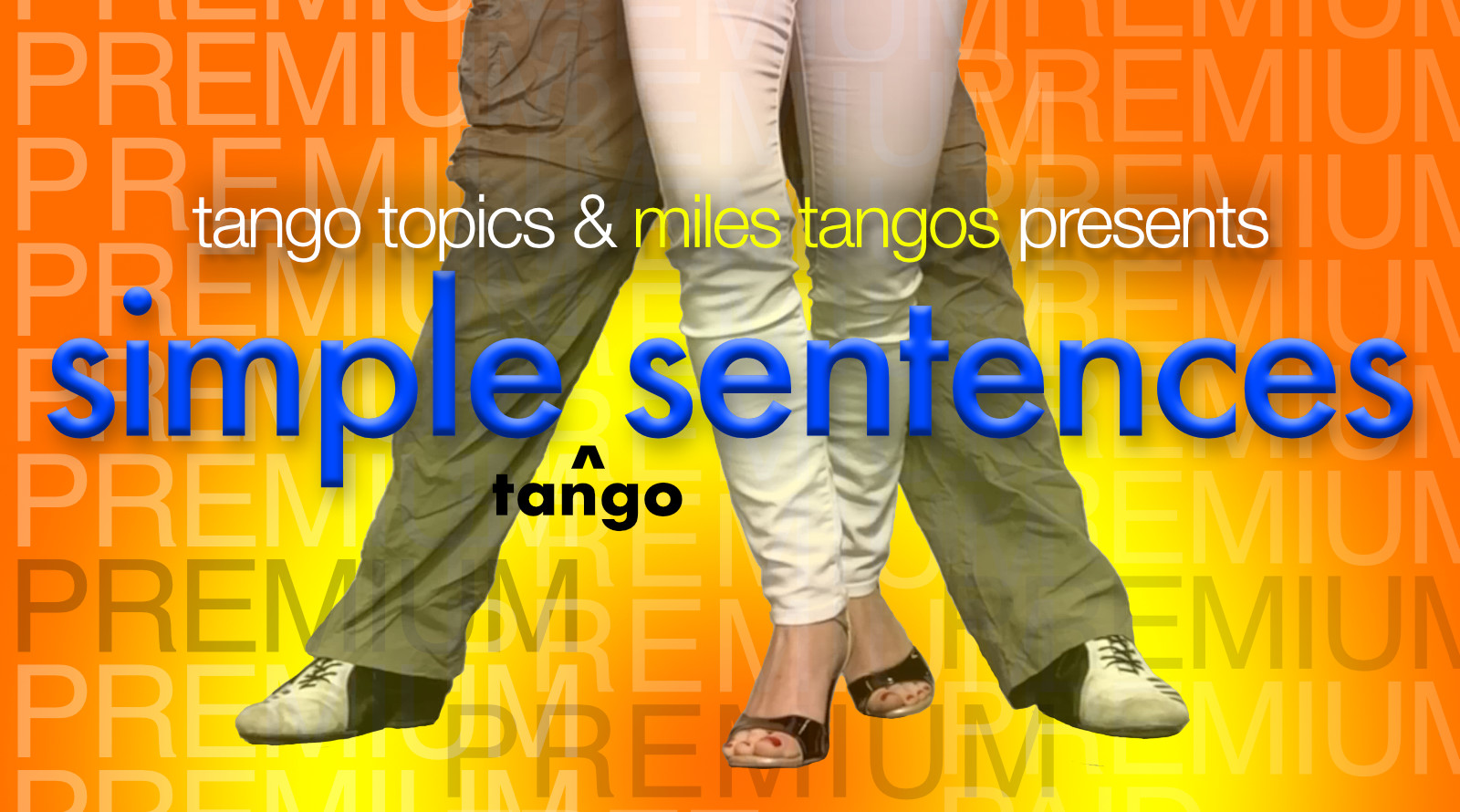The One about Simple Tango Sentences.
What is a Simple Sentence ?
A Simple Sentence refers to a Simple Tango Sentence. These are things we do all the time, without necessarily thinking about it. Only here, it’s deliberate and thought of. Put simply Simple Sentence uses simple tango ideas that we are all familiar with (walk, ocho, turn, cross, cortado) which are then strung together on the beat and then to the 5 Types of Musical Pauses.
The Simple Sentence methodology is just one way to use tango vocabulary to ‘Interpret’ the Music. Here are a few simple examples of Simple Tango Sentences in an ‘expression’ short hand.
Type 1 Walk (7 steps) before/after Type 2 Pause.
Type 3 Ocho (3 of them) before/after Type 1 Pause.
Type 3 Walk, Walk to the Cross at the Type 4 Pause.
Alternated Type 3 Ocho, Type 2 Walk, and then Walk to the Cross on the Type 4 Pause.
Those are Simple Tango Sentences.
If you’re wondering what all these ‘Types’ are, then here’s a reference that I know you won’t read but it will help you to understand what the types are:
https://tangotopics.com/musical-interpretation-just-the…
So why am I yapping about this today ?
I know this is going to sound like an ad for tangotopics but it’s not, I assure you. The reference material is all on TangoTopics but the idea is here for you to start to think about.
Another reason is that until rather recently there were only 3 ways to interpret the music:
1.) The “Enter Famous Teacher’s Name” Methodology. Where they came up with their idea of how to interpret the music. This usually involved a series of complex figures that they taught to keep you interested, and consequently fooled into thinking you were ‘learning’ tango. Sometimes this method worked really well. Most times … ummm … well. Ahem.
2.) The “Enter Famous Tango Performer’s Name” Methodology. This method shows you THEIR series of figures for a piece of music which you then copied, thinking that this will give you a leg up, and thereby allow you to be ‘creative’. Ahem.
or 3.) The Haphazard Methodology. This is where the dancer makes this sh1t up on the fly, which is typically what happens. And every once in a while, you nail it just right that it becomes a ‘magical connection’ (grrrrrrrr and you know I detest the use of that word) for you. So much so that you go back to that person over and over again expecting lightning to strike twice in the same bottle. Most times it does not but you keep going back anyway.
In cases 1 and 2, the idea is that if you rack up enough of these things, then you can cherry pick and ‘create’ a dance on the fly thereby making it look like you whipped this stuff up out of ‘thin-air’ (as opposed to ‘thick’). There are a few problems with this mindset. One of which is below. Still another is that after about 2 or 3 songs, people who are watching you will see that you are repeating X or Y with some frequency. It’s like looking at using the alphabet in the english language, and when you see it used, you see lots of E’s, A’s and O’s more frequently than you do M’s and S’s.
In all 3 cases they all rely heavily on memorizing steps, patterns, and/or figures. 9 times out of 10 these ‘figures’ correspond to precise inflections of the music in order to succeed.
Sometimes, as in the case of Tango Sincopè (pron: ‘seen-coh-pah’ – which is NOT a syncopation in traditional musical terms), these inflections occurred with a frequency, that if you knew the piece of music, you could anticipate and time the figure just perfectly the injection of a memorized step, pattern, or figure. And this seemed to work very well until it didn’t.
There are TWO problems with ALL 3 of these methodologies:
1.) The Complex Figure itself.
2.) Memorizing the Piece of Music to know where the inflections occur.
Enter SIMPLE SENTENCES and the 5 Pause Types!
When used properly, you don’t need to know either of those two things. Which is to say you don’t need to memorize a step or figure. And you don’t need to memorize the music.
Simple Sentences relies on 2 aspects which you already know: Simple Tango Vocabulary (Walk, Ocho, Turn, Cross, Cortado) and the natural Pauses in the Music (Stops, Flourishes, Diminished Notes, Musical Paragraphs, and the Singer’s Breath). The hard part for most people is learning to recognize the pauses in the music, and then learning to time things. NGL the first few times you try this stuff, you’re going to fail and fail miserably. But once you get the hang of it, the world is your oyster!
So why engage in the Simple Sentence Methodology ?
For one it creates less of a headache for both roles. Secondly, simplifies the dance in multiple ways by using what you already know to be true WITHOUT adding any more headroom. But if you wanted to be anal about this then here’s some math for you > There are 2,752,512 possibilities or variations on a theme by invoking the SIMPLE SENTENCE METHODOLOGY. Let that sink in. 2,752,512 at any one point in time, and that’s WITHOUT adding in the 5 pause types!
As a result this creates more pathways towards the idea of ‘Trancendence’ as defined previously > https://tangotopics.com/mile…/the-one-about-transcendance
Simple Sentences are part of Tango Topics, and they’re in your tangotopics library as a Basic or Premium User!
Simple Sentences methodology is an expression of the 5 Social Figures of Tango (https://tangotopics.com/five-figures/), which in case you’re unaware of are:
1.) The 6 Ways of Walking > https://tangotopics.com/walking-systems/
2.) The 8 Types of Ochos > https://tangotopics.com/eight-ochos/
3.) The 8 Types of Turns > https://tangotopics.com/eight-turns/
4.) The 256 Types of Argentine Crosses > https://tangotopics.com/256-argentine-cross-variations/
and 5.) The 8 Types of Ocho Cortados > https://tangotopics.com/ocho-cortado-options/

